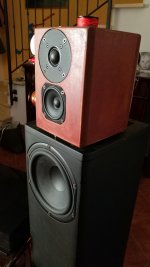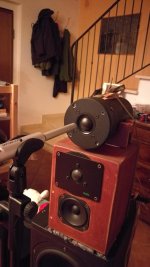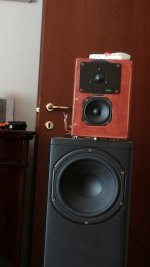Hello, I come from this thread and I've thought that it may be better to start another thread because original topic was quite different than this one.
It's time to publish my night-time measurements as suggested by you, putting microphone at various distance from driver.
Let's begin with the most important driver for me because driver which gave me more hard time, mr. Scanspeak D2905-9500 (follows as 'SS'), baffle-mounted as visible in previous photos (7.1 cm from left, 5.7 cm from top, 9.4 cm from right, 17.5 cm from bottom and 5.5 cm from Vifa edge), unfilterd (of course with just a 10 uF cap to protect from bass frequancies), flush mounted:
@5cm:
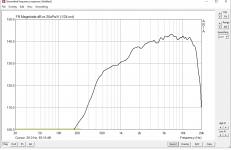
here we can see that driver is rather in perfect working conditions, just 6-7 khz slight peak that can be its tipical trademark
@50cm:
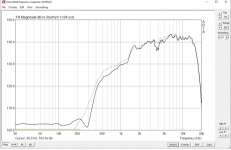
response begins to crinkle..
@100cm:
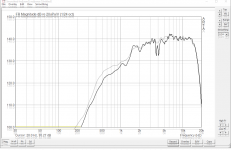
here response's crinkleness become paroxysmal!
Conclusion: SS in that baffle sounds very poorly
_________________________________________________
Now let's see SS's behaviour in baffle-less configuration, mounted on the front of a cilinder with its same diameter:
@5cm:
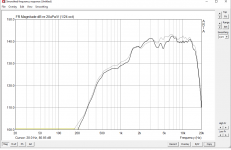
in grey overlayed baffle response at the same distance: baffle-less is more irregular evidently
@50cm:
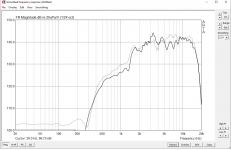
in grey overlayed baffle response at the same distance: baffle-less is as irregular as baffled, just in different region
@100cm:
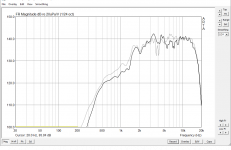
n grey overlayed baffle response at the same distance: baffle-less is less irregular as baffled
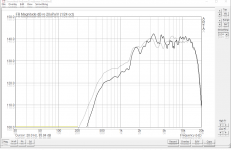
in grey overlayed baffle-less at 5 cm
Conclusion: we can see that baffle-less is less sensitive to distance from driver than baffled and maintains its timber at various distance.
_________________________________________________
For comparison, Sipe tweeter's measurement mounted on the same baffle (not flushed):
@100cm:
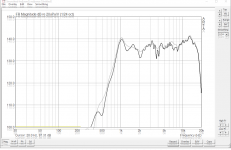
in grey overlayed response at 5 cm: there's still much crinkleness but maybe less than SS's one
_________________________________________________
For comparison, Vifa fullrange's measurement mounted on the same baffle under tweeter as visible in previous photos:
@100cm:
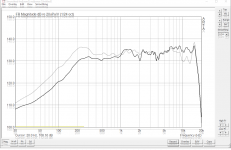
in grey overlayed response at 5 cm: there's crinkleness but less than previous situations
_________________________________________________
Here's final measurement of Vifa+SS as midrange+tweeter, took nearer than standard to verify flatness of crossover design without more possible crinkle's effects on distance:
@25cm:

Conclusion: seeing this chart response seems quite good... but.... listening is really horrible!! Full of harshness and sybilance!
Foolishly I didn't take the same measurement at 100cm but from what seen before we can deduce that summed response may be still a seismogram.
_________________________________________________
Now the questions:
- is my problem definitively a diffractions problem?
- if yes, why this diffraction shooted in this damned manner my project while there's at least a thousand project using a similar baffle, rather narrow, not well rounded on the edge of course, but however asymmetrical?
- may this problem be amplified by the wide dispersion feature of SS?
- if yes, may be a good choice to use in a narrow baffle as mine a waveguide to shrink dispersion and reduce baffle's interactions or it's time to migrate definetively to a baffle-less configurations remaining content of its however imperfect timber?
I also made some measurements with some felt around tweeter but without significant effects, probably due to my felt's non adapt features.
To see by the way this beatiful thread and a related very well made article Diffraction Doesn't Have to be a Problem about these issues.
Thank you very much!
It's time to publish my night-time measurements as suggested by you, putting microphone at various distance from driver.
Let's begin with the most important driver for me because driver which gave me more hard time, mr. Scanspeak D2905-9500 (follows as 'SS'), baffle-mounted as visible in previous photos (7.1 cm from left, 5.7 cm from top, 9.4 cm from right, 17.5 cm from bottom and 5.5 cm from Vifa edge), unfilterd (of course with just a 10 uF cap to protect from bass frequancies), flush mounted:
@5cm:

here we can see that driver is rather in perfect working conditions, just 6-7 khz slight peak that can be its tipical trademark
@50cm:

response begins to crinkle..
@100cm:

here response's crinkleness become paroxysmal!
Conclusion: SS in that baffle sounds very poorly
_________________________________________________
Now let's see SS's behaviour in baffle-less configuration, mounted on the front of a cilinder with its same diameter:
@5cm:

in grey overlayed baffle response at the same distance: baffle-less is more irregular evidently
@50cm:

in grey overlayed baffle response at the same distance: baffle-less is as irregular as baffled, just in different region
@100cm:

n grey overlayed baffle response at the same distance: baffle-less is less irregular as baffled

in grey overlayed baffle-less at 5 cm
Conclusion: we can see that baffle-less is less sensitive to distance from driver than baffled and maintains its timber at various distance.
_________________________________________________
For comparison, Sipe tweeter's measurement mounted on the same baffle (not flushed):
@100cm:

in grey overlayed response at 5 cm: there's still much crinkleness but maybe less than SS's one
_________________________________________________
For comparison, Vifa fullrange's measurement mounted on the same baffle under tweeter as visible in previous photos:
@100cm:

in grey overlayed response at 5 cm: there's crinkleness but less than previous situations
_________________________________________________
Here's final measurement of Vifa+SS as midrange+tweeter, took nearer than standard to verify flatness of crossover design without more possible crinkle's effects on distance:
@25cm:

Conclusion: seeing this chart response seems quite good... but.... listening is really horrible!! Full of harshness and sybilance!
Foolishly I didn't take the same measurement at 100cm but from what seen before we can deduce that summed response may be still a seismogram.
_________________________________________________
Now the questions:
- is my problem definitively a diffractions problem?
- if yes, why this diffraction shooted in this damned manner my project while there's at least a thousand project using a similar baffle, rather narrow, not well rounded on the edge of course, but however asymmetrical?
- may this problem be amplified by the wide dispersion feature of SS?
- if yes, may be a good choice to use in a narrow baffle as mine a waveguide to shrink dispersion and reduce baffle's interactions or it's time to migrate definetively to a baffle-less configurations remaining content of its however imperfect timber?
I also made some measurements with some felt around tweeter but without significant effects, probably due to my felt's non adapt features.
To see by the way this beatiful thread and a related very well made article Diffraction Doesn't Have to be a Problem about these issues.
Thank you very much!
I wrap tweets and horns in open cell foam or f10 felt.
I have no measurements.
But it sounds "sharper", or a bit more detail.
I have no measurements.
But it sounds "sharper", or a bit more detail.
I enjoy a chat with some of diyaudio's brighter lights.
IMO, Michael Chua is one of them:
Dome Tweeters – are manufacturers’ Response plots realistic? – AmpsLab
He likes the Morel CAT378 which I want to try:
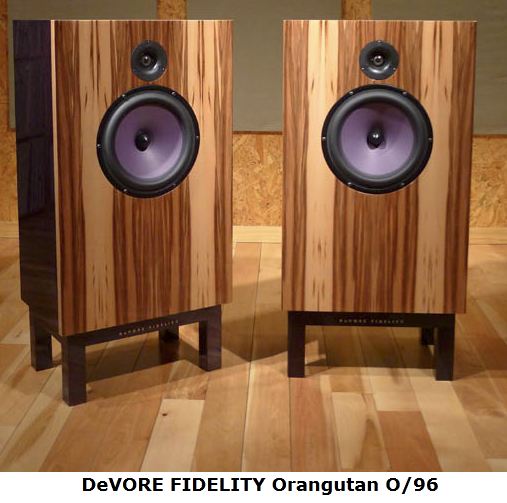
He also likes the Morel MDT29, aka the Morel CAT298 which I happen to have:
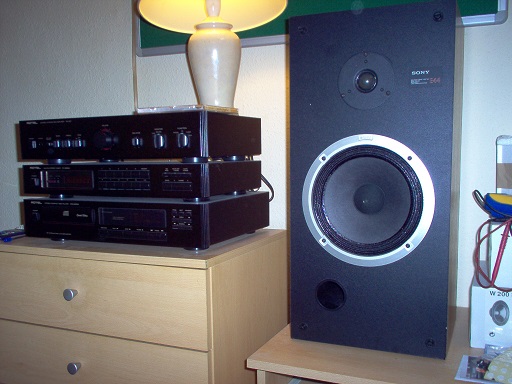
TBH, I think the CAT298 is a stinker! Harsh, spitty and sibilant even on my best 4th. order crossover. Maybe I need a good foam-filled grille? 😕
IMO, Michael Chua is one of them:
Dome Tweeters – are manufacturers’ Response plots realistic? – AmpsLab
He likes the Morel CAT378 which I want to try:
He also likes the Morel MDT29, aka the Morel CAT298 which I happen to have:
TBH, I think the CAT298 is a stinker! Harsh, spitty and sibilant even on my best 4th. order crossover. Maybe I need a good foam-filled grille? 😕
No, you need to stop thinking the way you fancy so much and admit it to yourself. Not once in my life have I come across a tweeter that was not managable to perform decently, and I never guess a crossover, nor do I rely on manufacturer's plots. I do my own each time.
Last edited:
IMO, the greatest speaker genius was Steen Duelund.
TBH, it seems like only me and John Kreskovsky understood him. John is an algebra man, me, I like geometry.
Nobody here ever got this Steen Duelund idea:
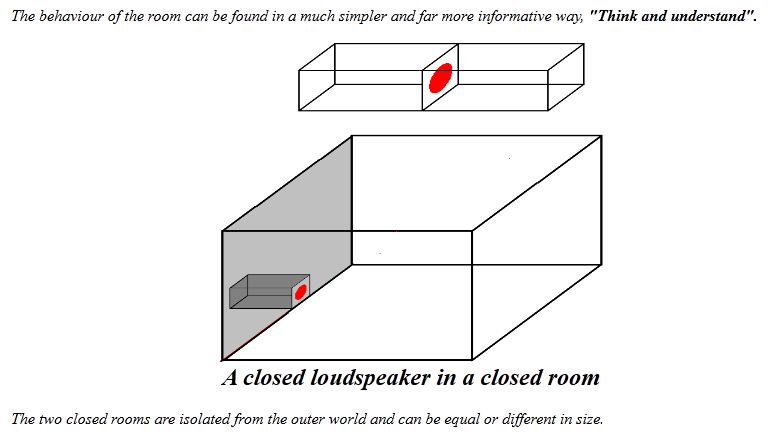
What he is telling us is the speaker cabinet is no different from the room. Pure genius, IMO. You might line the inside of your cabinet with damping. Steen says you might as well line your room or the outside of the cabinet!
How good is that? 😀
TBH, speakers are small beer IMO. A mere 2-dimensional Clifford algebra. The serious Physics people have moved into much higher dimensions. But sufficiently simple to be accessible. Sufficiently complex to be interesting.
It's all about that fascinating Transcendental number "Pi" in the end:
Quanta Magazine
Not many people know this, but for every algebraic number you know, there are infinitely many more transcendentals. Yet we really only know "Pi" and "e".
🙂
TBH, it seems like only me and John Kreskovsky understood him. John is an algebra man, me, I like geometry.
Nobody here ever got this Steen Duelund idea:
What he is telling us is the speaker cabinet is no different from the room. Pure genius, IMO. You might line the inside of your cabinet with damping. Steen says you might as well line your room or the outside of the cabinet!
How good is that? 😀
TBH, speakers are small beer IMO. A mere 2-dimensional Clifford algebra. The serious Physics people have moved into much higher dimensions. But sufficiently simple to be accessible. Sufficiently complex to be interesting.
It's all about that fascinating Transcendental number "Pi" in the end:
Quanta Magazine
Not many people know this, but for every algebraic number you know, there are infinitely many more transcendentals. Yet we really only know "Pi" and "e".
E.T. Bell said:"The algebraic numbers are spotted over the plane like stars against a black sky; the dense blackness is the firmament of the transcendentals."
🙂
What he is telling us is the speaker cabinet is no different from the room. Pure genius, IMO. You might line the inside of your cabinet with damping. Steen says you might as well line your room or the outside of the cabinet!
How good is that? 😀
there is a huge difference in size between the smaller box and the larger room, that makes them behave very differently, just look at the high pressure inside a speaker box for one parameter, another parameter is that you for most part sit in the room and not in the loudspeaker enclosure, unless you are using open baffle designs
How old are your D2905-9500 ? the ferrofluid is perhaps dry.
that could be an issue, but in my experience with dried ferrofluids makes the tweeter sensitivity drop like a stone (in a pond)
that could be an issue, but in my experience with dried ferrofluids makes the tweeter sensitivity drop like a stone (in a pond)
I'm not the designer of the loudspeaker unit, and i don't know if the viscosity of the fluid have a effect on the dome damping, but i can imagine that some dust agglomerated with dryed fluid residues can touch the coil, perhaps.
Last edited:
What he is telling us is the speaker cabinet is no different from the room. Pure genius, IMO. You might line the inside of your cabinet with damping. Steen says you might as well line your room or the outside of the cabinet!
How good is that? 😀
Sometimes I'm a bit slow. You're being sarcastic/ironic, right?
All I'd want to understand is if this situation:
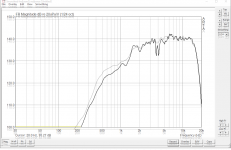
of my SS D2905-9500 on a baffle 16.5 cm large and 27.0 cm tall in asymmetric position and mic at 100 cm has to be considered 'normal' or really there's something of strongly wrong in something that I can't understand (I don't think it can be missing ferrofluid because the near-field response is quite good).
Let's try to see problem by another point of view. Supposing I won't be able to fight completely harshness and sybilance for a baffle problem or other, what makes a tweeter sound in the opposite manner than harshness, that is 'sweetly' and 'warmly'? What's the cross topology that gives tweeter more those footprints than others, if it can be possible to say so?
For a tweeter exists many different approaches, and I'd want to understand if their difference is due only and just to match with lower conterminous driver or is due also to give a certain character to sound output.
I've seen, for example, that major differences stay often in the 'position' of attenuation series resistor, some use it before the entire filter, some after just near driver; another thing I think related to this is the Q of the main cell, some use a Q near to theoretical, some use a more resonant Q united with a resistor of the 'before filter' type.
For example, Dennis Murphy in New Vifa Tower for the same SS D2905-9500 uses a 8 uF cap, a 0.3 mH inductor and a 3 ohm series resistor 'after' filter:
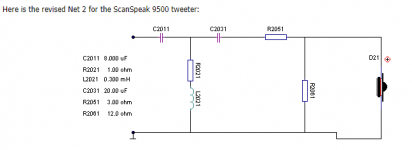

________________________________________________________
Another big project-maker as Zaph Audio in his ZA-SR71 project uses for the Vifa 27TDFC (moreover very very similar to SS D2905-9500 for its specs and response) a totally different approach, a strongly resonant cell with a big 12 uF cap and a little 0.15 mH inductor, and a 4 ohm series resistor 'before':
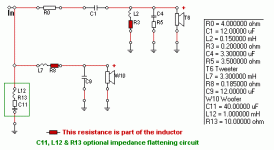
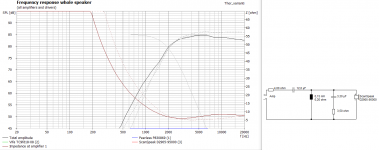
Why a similar solution, what's the effects on timber?
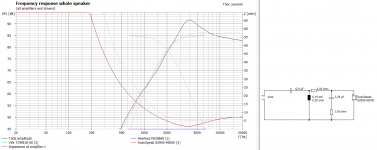
(this is what it would be if resistor was put 'after')
_______________________________________________________
What of these two solutions' output timber is 'warmer' and 'sweeter', more safe from harshness?

of my SS D2905-9500 on a baffle 16.5 cm large and 27.0 cm tall in asymmetric position and mic at 100 cm has to be considered 'normal' or really there's something of strongly wrong in something that I can't understand (I don't think it can be missing ferrofluid because the near-field response is quite good).
Let's try to see problem by another point of view. Supposing I won't be able to fight completely harshness and sybilance for a baffle problem or other, what makes a tweeter sound in the opposite manner than harshness, that is 'sweetly' and 'warmly'? What's the cross topology that gives tweeter more those footprints than others, if it can be possible to say so?
For a tweeter exists many different approaches, and I'd want to understand if their difference is due only and just to match with lower conterminous driver or is due also to give a certain character to sound output.
I've seen, for example, that major differences stay often in the 'position' of attenuation series resistor, some use it before the entire filter, some after just near driver; another thing I think related to this is the Q of the main cell, some use a Q near to theoretical, some use a more resonant Q united with a resistor of the 'before filter' type.
For example, Dennis Murphy in New Vifa Tower for the same SS D2905-9500 uses a 8 uF cap, a 0.3 mH inductor and a 3 ohm series resistor 'after' filter:


________________________________________________________
Another big project-maker as Zaph Audio in his ZA-SR71 project uses for the Vifa 27TDFC (moreover very very similar to SS D2905-9500 for its specs and response) a totally different approach, a strongly resonant cell with a big 12 uF cap and a little 0.15 mH inductor, and a 4 ohm series resistor 'before':


Why a similar solution, what's the effects on timber?

(this is what it would be if resistor was put 'after')
_______________________________________________________
What of these two solutions' output timber is 'warmer' and 'sweeter', more safe from harshness?
You really making the graph overlays with Microsoft paint or similar software? There is a graph overlay option in ARTA.
People put resistors in the circuit where they get the response (frequency and impedance either) they want.
Anyway, a harmonic distortion, waterfall (cumulative spectral decay) and off-axis response may would be helpful to see.
People put resistors in the circuit where they get the response (frequency and impedance either) they want.
Anyway, a harmonic distortion, waterfall (cumulative spectral decay) and off-axis response may would be helpful to see.
SS on baffle:
View attachment 823431
..and there is the problem right there - I can see it plainly. (..and it will get worse with an increase in spl.)
The lack of baffle round-over is also a bit of a problem.
Anyone else?
Last edited:
Tweeter face plate looks recessed, not flush. Screws could do with being recessed and having some sort of putty smoothed over. Tweeter almost the same distance from 3 edges. (distances seem to match wavelengths of 5k to 8k)
Maybe try a layer of felt with a cutout for the dome. I think I remember an interesting 'star' shaped cutout to smooth the transition (Planet10 maybe?)
Rob.
Maybe try a layer of felt with a cutout for the dome. I think I remember an interesting 'star' shaped cutout to smooth the transition (Planet10 maybe?)
Rob.
Last edited:
It looks like a diffraction artifact. The wavelength it happens is around 8,5 cm. It may not be a coincidence that you find that same dimension in your loudspeaker (it is half the width of your tweeter enclosure).
Actually, I think the result with the bare tweeter is slightly worse. The dip in the enclosure is deeper, but higher Q (narrower) than that with the tweeter outside the enclosure. High Q peaks and dips are less audible than low Q peaks and dips.
One way to be sure is to take a couple of books of about the same size of your enclosure and use them to broaden it. If you see your dip moving to the left, you found your culprit.
Actually, I think the result with the bare tweeter is slightly worse. The dip in the enclosure is deeper, but higher Q (narrower) than that with the tweeter outside the enclosure. High Q peaks and dips are less audible than low Q peaks and dips.
One way to be sure is to take a couple of books of about the same size of your enclosure and use them to broaden it. If you see your dip moving to the left, you found your culprit.
This is not how you do it. If you want to remove the baffle you'll want to use a large baffle.in baffle-less configuration
Well, thank you very much for your precious suggestions.
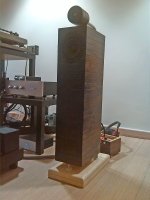
And what about high-pass filter topology using high Q cell with a resistor before to tame peak? What's the reason why some filters designer uses this kind of circuitry?
Since I've been convinced to be able to design crossover just with builder's measurements and a good simulator, I've got only strong disappointments. Crossover design is a difficult matter, is enough to see three totally different circuitry obtaining the same 'apparent' response curve:
Zaph's approach matching a SEAS ER18RNX:
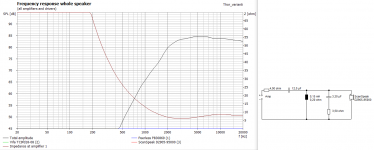
Another approach:
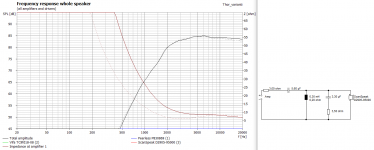
Still another approach:
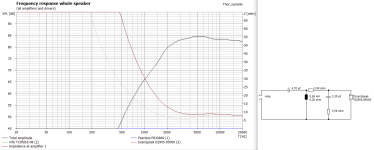
How is it possible to have the same curve from circuitries with so different values? It's obvious that these system will have strong sonic differences, but from simulation it's impossible to see it before building. How is it possible, if so, to approximately forecast the sonic result from a simulation?
In the end, Michael Chua's Starling approach ever matching the same ER18RNX of the first simulation:
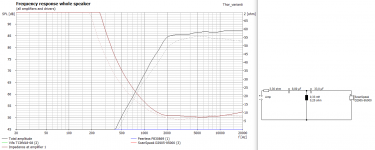
On the contrary, even a different curve with another very good sounding solution.
In conclusion, crossover's project equation will never have solution for a beginner like me. Let's add diffraction problems and I'll be able definitively to launch everything out from window..What a sin!
Still hope somebody will reveal magician behind good sounding crossovers.
Of course, 'baffle-less' was to be intended 'without' any baffle around. I've been curious about this topology when listened at an audio exposition this simple two way usign a Seas ER18RNX and a Scanspeak D2608-913000 sounding incredibly well..This is not how you do it. If you want to remove, the baffle you'll want to use a large baffle.

And what about high-pass filter topology using high Q cell with a resistor before to tame peak? What's the reason why some filters designer uses this kind of circuitry?
Since I've been convinced to be able to design crossover just with builder's measurements and a good simulator, I've got only strong disappointments. Crossover design is a difficult matter, is enough to see three totally different circuitry obtaining the same 'apparent' response curve:
Zaph's approach matching a SEAS ER18RNX:

Another approach:

Still another approach:

How is it possible to have the same curve from circuitries with so different values? It's obvious that these system will have strong sonic differences, but from simulation it's impossible to see it before building. How is it possible, if so, to approximately forecast the sonic result from a simulation?
In the end, Michael Chua's Starling approach ever matching the same ER18RNX of the first simulation:

On the contrary, even a different curve with another very good sounding solution.
In conclusion, crossover's project equation will never have solution for a beginner like me. Let's add diffraction problems and I'll be able definitively to launch everything out from window..What a sin!
Still hope somebody will reveal magician behind good sounding crossovers.
Tweeter face plate looks recessed, not flush. Screws could do with being recessed and having some sort of putty smoothed over. Tweeter almost the same distance from 3 edges. (distances seem to match wavelengths of 5k to 8k)
Maybe try a layer of felt with a cutout for the dome. I think I remember an interesting 'star' shaped cutout to smooth the transition (Planet10 maybe?)
Rob.
BINGO!
It's actually better to use soft silicone caulk to push the tweeters into a flat position (relative to the baffle) and "fill" the area around the transition between face-plate and baffle. Basically you just caulk the inside "ring" of the baffle and face-plate connection area for the tweeter and slide it into place. This not only gets rid of the problem, but also lowers vibration from the baffle surface to the tweeter.
The vertical baffle-edge-to-tweeter-face-plate isn't great either with such an abrupt transition.
Last edited:
- Home
- Loudspeakers
- Multi-Way
- May my problem be diffraction?
